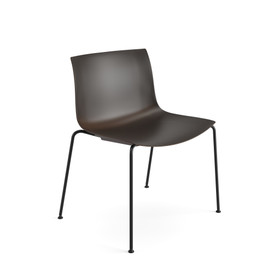
Catifa Carta
Catifa 53, designed in 2001 and Arper’s first product with an environmental product declaration, enters a new era through a partnership in material innovation. Catifa Carta features a re-engineered shell made of PaperShell, a revolutionary new material made of composite wood by-product, which provides the strength and comfort essential to Catifa’s now iconic, bi-curved silhouette. A first of its kind innovation, PaperShell dramatically reduces Catifa Carta’s impact on the environment by doing what trees do: sequestering carbon dioxide. At the end of its life cycle, the material can be reduced to biochar, successfully retaining the CO2 sequestered during the previous life phases. The new Catifa Carta is as transformative in style and beauty as the original, now setting a new standard for sustainable design.
With a shell composed of bi-curved, paper-derived new material, Catifa Carta offers a new vision with renewed sustainability ambitions. The PaperShell material is the result of advanced scientific research, innovating a process that tackles the climate challenges practically – and Arper is the first manufacturer in the design industry to apply it to a product. The shell of Catifa Carta is available in a coffee color and the base in three options: steel base 4 legs in black, steel sled base in black and rust, black aluminum trestle base with and without wheels. Cushions and removable cover options are available to add color and extra comfort. To further reduce its environmental impact and allow for a longer life cycle, Catifa Carta is fully disassemblable. We are also working to define the most efficient take back solutions to ensure responsible end of life.


Introducing Catifa Carta
What does material regeneration look like?
Design By

Lievore Altherr Molina
2001, Collection Extension 2024
Downloads
Awards

People's Choice - AZ Awards, CA
2022

Delta Awards, SP
2022

FX International Design Awards, UK
2021

Mixology North 21 Awards, UK
2021

A REVOLUTIONARY MATERIAL
Catifa Carta's shell is crafted entirely from PaperShell, a groundbreaking material derived from paper. Comprising 29 sheets of paper bonded with a natural resin binder, Catifa Carta significantly reduces the chair's environmental footprint by sequestering carbon dioxide. Paper used to produce PaperShell is sourced responsibly, utilizing residues from Swedish wood production such as sawdust, chips, and branches.
At the end of its lifecycle, Catifa Carta can undergo pyrolysis, a burning process that happens in absence of oxygen and prevents CO2 release. Through pyrolysis PaperShell is converted into biochar. Biochar is a form of charcoal produced from plant matter made up of up to 90% of carbon, which locks CO2 effectively, avoiding its release into the atmosphere. Biochar is best used as soil enhancement, helping to restore the soil to its natural richness and hence supporting biodiversity, the key for a healthier and more balanced environment.
Discover more

A CIRCULAR PROCESS

Organic Origin
Wood by-products and timber waste are collected, shredded and transformed into paper pulp, to be used for the realization of kraft paper.

From Paper to Catifa Carta
The kraft paper is impregnated with a 100% biogenic hemicellulose based binder from agro-waste streams or pulp and paper production. The impregnated substrates are stacked, pressed and cut into the shell of Catifa Carta.

Biochar Carbon Locking
At the end of its life, the shell of Catifa Carta is transformed into stable biochar through pyrolysis, a low oxygen burning process that prevents carbon from being released into the atmosphere. When mixed with soil, it becomes a home for mycelium and microbes to create new life.

Closing the Loop
The biochar can be used as a soil enhancement and, in combination with mycelium and microbes, used as soil for regenerative reforestation and agriculture projects to promote biodiversity.
IN DEPTH

Recycled input materials used
Circularity score of 43% (TECLA Tool), 45.68% renewable materials used

Weight of produced goods
Emission intensity ratio (weight, kg CO2eq/kg): 4.31

BIA(B Impact Assessment)Score
Synesgy ESG rating: B, Open-ES: 86/100

Incidents related to safety
5.4% positive delta of turnover (new hires vs. terminations)


































